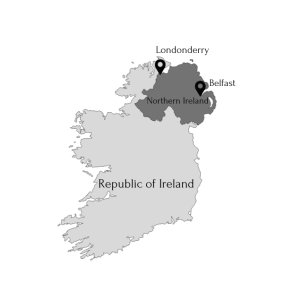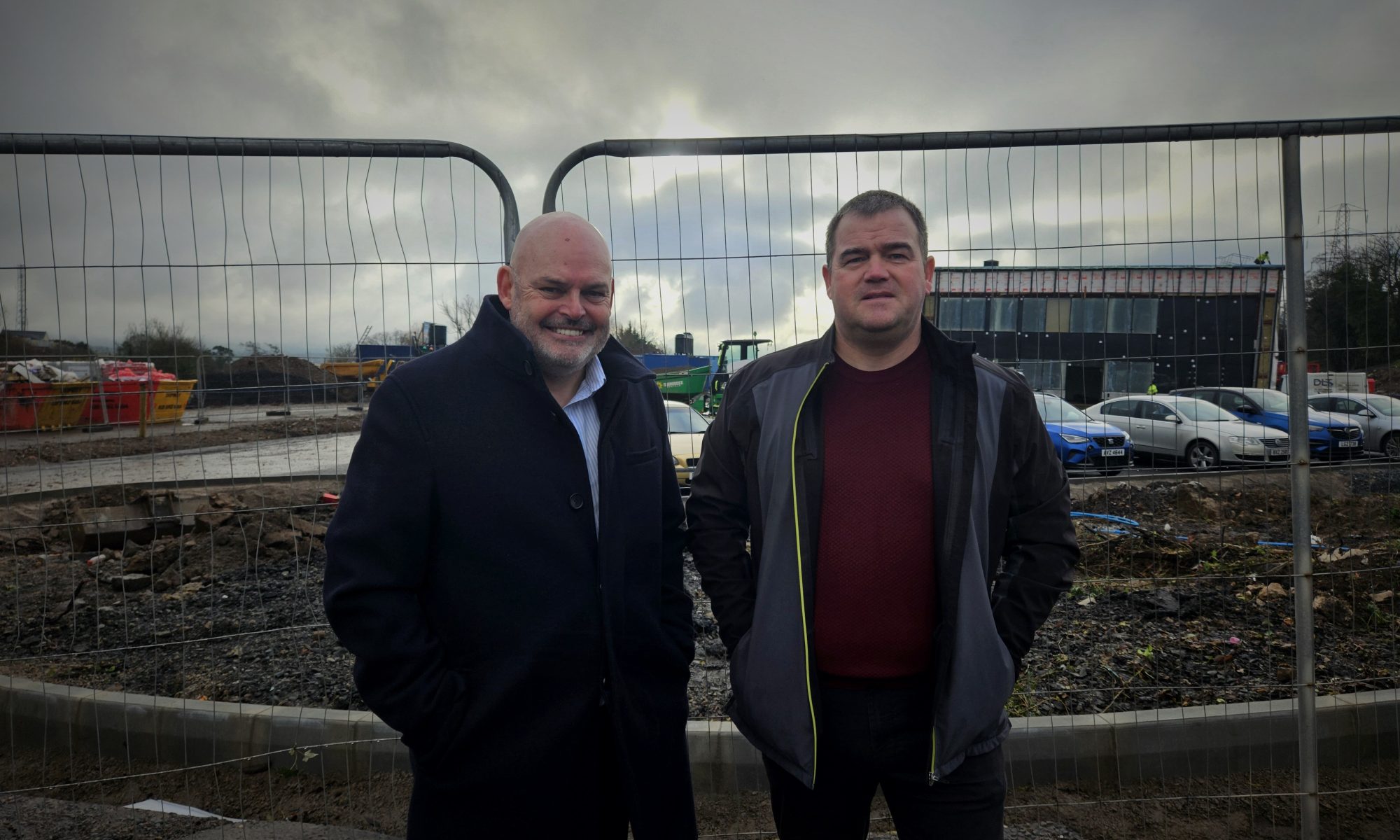
The year 2023 was supposed to be a milestone for Northern Ireland, but the ten-year plan to dismantle all walls between Protestant and Catholic communities is falling short. These structures were built by the military during the Troubles for safety. People still think they offer protection, even though the conflict ended. But that doesn’t mean everyone is unchanging in their views.
Over the years, various peace initiatives have made significant strides in bridging the gap left by the Troubles and navigating the challenges that come with it. Even though the walls are still there, efforts for reconciliation keep making progress, showing ongoing changes in the post-conflict landscape.
[aesop_video src=”youtube” id=”QapcqvHzi_Q” align=”center” disable_for_mobile=”on” loop=”on” controls=”on” mute=”off” autoplay=”off” viewstart=”off” viewend=”off” show_subtitles=”off” revealfx=”off” overlay_revealfx=”off”]
Painfully slow process
In the capital of Northern Ireland, towering murals and fences serve as constant reminders of the tumultuous past from three decades ago. During the conflict, big barriers went up to protect the two communities. A wall over a kilometer long and six meters high has been there since 1989, running from Springmartin Road to Ballygomartin Road in west Belfast. In 1972, seven lives were lost on this street. Not far away is Shankill Road, with graffiti-covered fences standing fifteen meters tall. In 1993, nine people died in this area, and over fifty were injured.
[aesop_image img=”https://svjmedia.nl/mirkavanderboom/wp-content/uploads/sites/629/2024/01/02-northern-ireland-tourism.jpeg” panorama=”off” credit=”Nurphoto/Getty ” align=”center” lightbox=”on” captionsrc=”custom” caption=”The wall surrounding Springmartin Road, serving as a divisive barrier between the working-class neighborhoods of Catholics and Protestants.” captionposition=”left” revealfx=”off” overlay_revealfx=”off”]
Only fourteen years ago, a crucial moment occurred for the locals, demanding change. It occurred when a car, loaded with explosives by the IRA (Irish Republican Army), caught fire but did not explode near the desolate police station at the end of Springmartin Road.
After years of talking with residents, the Black Mountain Shared Space Project, a peace initiative, successfully took down a section of the brick wall last year. Instead, they plan to construct a new community space to further unite the separated communities. Currently nestled on a hillside near the street, the existing building hosts various activities, including cookery and, quite fittingly for December, the organization of a Christmas market.
Bridging the gap this way works well, says project manager Seamus Corr, with his strong Northern Irish accent. “But it is a painfully slow process. Much too slow for my liking”, he adds.
Heavy lifting
The neighbourhoods around Springmartin Road urgently need revitalization. High unemployment and a shortage of opportunities define daily life. According to a recent report from the Joseph Rowntree Foundation (JRF) said poorer children would live for about 15 fewer years in “good health” than children from richer backgrounds. The charity concluded overall poverty in Northern Ireland is the lowest of any country within the United Kingdom. Corr emphasizes that the negligence of the Northern Irish government, which has been non-functional for almost two years, poses a significant problem.
Many still vote based on their loyalty to a particular group. The Democratic Unionist and Ulster Unionist parties are mostly Protestant, while the Social Democratic and Labour Party and Sinn Féin are mostly Catholic. “No matter how much there’s a peace process and a national-level agreement, it doesn’t translate to the ground for some residents”, Seamus Corr explains.
“There’s no alternative way of forming a government because the Good Friday Agreement says we need both unionists and nationalists”, says David Mitchell, professor at the renowned Trinity College in Dublin, specialized in the peace process in Northern Ireland. If this arrangement cannot be maintained, the government must cease to function. Civil servants are currently in charge, but they lack the authority to make crucial decisions. “There is no plan B”, he adds.
[aesop_image img=”https://svjmedia.nl/mirkavanderboom/wp-content/uploads/sites/629/2023/12/20231211_113813-scaled.jpg” panorama=”off” credit=”Mirosława van der Boom” align=”center” lightbox=”off” captionsrc=”custom” caption=”From left to right: Peter Osborne and Seamus Corr standing in front of a new community centre at Black Mountain, West Belfast.” captionposition=”left” revealfx=”inplaceslow” overlay_revealfx=”off”]
Peter Osborne, a board member of International Funding for Ireland, emphasizes the importance of subsidizing local peace initiatives. According to Osborne, only they truly understand the on-the-ground reality and, as a result, are the best mediators. “Seamus isn’t a politician, but he will work between communities to make this place a better place, despite the politics, facilitated by him”, he says. “You’ll have a lot of community organizations springing up to handle the heavy lifting for workers, as the peace process has developed over the last 25 years.” A study from the biggest research organization concludes the same: most residents in Belfast, Londonderry and Portadown look for advice within their local communities. The heroes and heroines in this community are the local organizations, with many women actively participating in peace process-related activities, says Osborne. “They were able to do things that other people didn’t want to.”
[aesop_image img=”https://svjmedia.nl/mirkavanderboom/wp-content/uploads/sites/629/2023/12/20231211_102223-scaled.jpg” panorama=”off” credit=”Mirosława van der Boom” align=”center” lightbox=”off” captionsrc=”custom” caption=”The junction of Ballygomartin Road and Springmartin Road.” captionposition=”left” revealfx=”inplaceslow” overlay_revealfx=”off”]
[aesop_video src=”youtube” id=”OYvPQCzZ4gM” align=”center” disable_for_mobile=”on” loop=”on” controls=”off” mute=”off” autoplay=”off” viewstart=”off” viewend=”off” show_subtitles=”off” revealfx=”inplace” overlay_revealfx=”off”]
Making compromises
The border town of Londonderry, much like Belfast, is adorned with murals and fences that refuse to let you forget the historical events. The Protestant neighbourhood in The Fountain is still surrounded by a tall wall, featuring large cameras on the fence. Like in Belfast, the metal gate to the neighbourhood is securely locked every evening and only opens in the early morning. The Bogside and Brandywell Initiative, aims to revitalize the city’s image surrounding these walls for almost twelve years now. Kyra Reynolds, a staff member at the initiative, has been working since 2019 to improve the city’s image around these walls. Reynolds has observed that the situation in Londonderry is somewhat different from Belfast. In Londonderry are Catholics the majority.
[aesop_image img=”https://svjmedia.nl/mirkavanderboom/wp-content/uploads/sites/629/2023/12/20231214_160723-scaled.jpg” panorama=”off” credit=”Mirosława van der Boom” align=”center” lightbox=”on” captionsrc=”custom” caption=”From left to right: Kyra Reynolds and Paula Flanaghan standing on the old city walls besides the remaining fence in Londonderry.” captionposition=”left” revealfx=”inplaceslow” overlay_revealfx=”off”]
A small portion of the fencing on the historic city walls will be retained. The initiative had to make compromises with the Protestant Apprentice Boys to maintain the fence in front of their building. They remain apprehensive about its removal. “Initially, it looked quite ugly with that corrugated iron along the walls, so we wanted to at least give it a fresh appearance. The Apprentice Boys were open to that”, says Reynolds. However, she acknowledges that this is a prime example of how slow the peace process can be. It took eleven years for such a small step to be taken, she notes.
[aesop_image img=”https://svjmedia.nl/mirkavanderboom/wp-content/uploads/sites/629/2024/01/20231214_160434-scaled.jpg” panorama=”off” credit=”Mirosława van der Boom” align=”center” lightbox=”on” captionsrc=”custom” caption=”A small part of the fence remains on the old city walls of Londonderry in front of the Apprentice Boys.” captionposition=”left” revealfx=”inplaceslow” overlay_revealfx=”off”]
City image
What primarily draws tourists to visit Belfast or Londonderry are the murals. This type of dark tourism generates significant revenue, which is crucial after Brexit, according to Reynolds. “Tourism is also one of the reasons why the walls remain in place. And if there is peace, what do we do then? We would lose a lot of jobs”, Paula Flanaghan, another staff member who sits next to Reynolds, explains. However, the peace initiative deems the new murals that still depict the Troubles unnecessary. “We need other reasons for people to visit Londonderry”, she says. “Is this still the image we want to create? I’m not against the murals, but if they are used to designate territory as Protestant or Catholic, then that’s a problem”, Reynolds concludes.
[aesop_image img=”https://svjmedia.nl/mirkavanderboom/wp-content/uploads/sites/629/2024/01/20231214_155758-scaled.jpg” panorama=”off” credit=”Mirosława van der Boom” align=”center” lightbox=”on” captionsrc=”custom” caption=”In the Protestant area called ‘The Fountain’. On the right, you see the fence that divides Bishop Street with The Fountain. On the left, one of the examples of conflict architecture is noticeable. Reynolds calls it a ‘just in case fence’.” captionposition=”left” revealfx=”off” overlay_revealfx=”off”]
[aesop_image img=”https://svjmedia.nl/mirkavanderboom/wp-content/uploads/sites/629/2024/01/20231214_155332-2-scaled.jpg” panorama=”off” credit=”Mirosława van der Boom” align=”right” lightbox=”on” captionsrc=”custom” caption=”The entrance to The Fountain. It’s the only gate in Londonderry that closes at 9PM.” captionposition=”left” revealfx=”inplaceslow” overlay_revealfx=”off”]
Communication
According to Reynolds, the peace process in Londonderry involves what she refers to as the “soft work”, such as crafting or attending a book club. “This initiates conversations, and eventually, they realize they come from opposite sides of the interface. But it doesn’t really matter any more because now they are friends”, she explains.
The challenging part, also termed as the “hard work”, involves engaging directly with individuals from all perspectives who have been impacted by the conflict. The shared stories are often graphic. Reynolds cites workshops featuring speakers who have experienced the Troubles in various ways – it could be a former soldier, a loyalist, a former IRA member, or individuals who have lost family members. “They come together in a space, go around tables, and ask any questions they want. The typical reaction is: ‘Oh, I had no idea about this.’ Well, that’s because you haven’t spoken to each other before”, she notes.
[aesop_image img=”https://svjmedia.nl/mirkavanderboom/wp-content/uploads/sites/629/2024/01/20231207_171352-scaled.jpg” panorama=”off” credit=”Mirosława van der Boom” align=”center” lightbox=”on” captionsrc=”custom” caption=”In the Protestant area, The Fountain, at night.” captionposition=”left” revealfx=”inplaceslow” overlay_revealfx=”off”]
Uncertainty
But since Brexit, the clock has started ticking for these peace initiatives. “Peace funding from the EU said that they would go for another spell, but after that they would finish it”, Reynolds explains. The initiative heavily depends on the European Social Fund, an EU funding pool for job creation, especially in marginalized communities. However, with the new post-Brexit rules in place in 2024, the region will lose access to this budget. “Thankfully, that spell’s only starting now and will finish in 2027.” Reynolds is referring to the newly launched ‘Peace Plus programme‘, which has been operational since 2022. But, what unfolds after 2027 remains uncertain.

